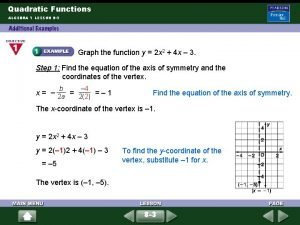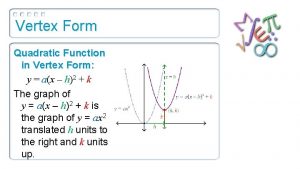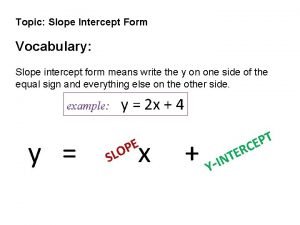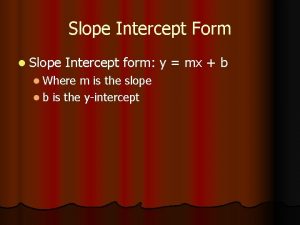Graphing Quadratic Functions in Vertex or Intercept Form
















- Slides: 16

Graphing Quadratic Functions in Vertex or Intercept Form • Definitions • 3 Forms • Steps for graphing each form • Examples • Changing between eqn. forms

Quadratic Function • A function of the form y=ax 2+bx+c where a≠ 0 making a u-shaped graph called a parabola. Example quadratic equation:

Vertex • The lowest or highest point of a parabola. Vertex Axis of symmetry • The vertical line through the vertex of the parabola. Axis of Symmetry

Vertex Form Equation y=a(x-h)2+k • If a is positive, parabola opens up If a is negative, parabola opens down. • The vertex is the point (h, k). • The axis of symmetry is the vertical line x=h. • Don’t forget about 2 points on either side of the vertex! (5 points total!)

Vertex Form v. Each function we just looked at can be written in the form (x – h)2 + k, where (h , k) is the vertex of the parabola, and x = h is its axis of symmetry. v(x – h)2 + k – vertex form Equation Vertex Axis of Symmetry y = x 2 or y = (x – 0)2 + 0 (0 , 0) x=0 y = x 2 + 2 or y = (x – 0)2 + 2 (0 , 2) x=0 y = (x – 3)2 or y = (x – 3)2 + 0 (3 , 0) x=3

Example 1: Graph y = (x + 2)2 + 1 • Analyze y = (x + 2)2 + 1. • Step 1 Plot the vertex (-2 , 1) • Step 2 Draw the axis of symmetry, x = -2. • Step 3 Find and plot two points on one side , such as (-1, 2) and (0 , 5). • Step 4 Use symmetry to complete the graph, or find two points on the • left side of the vertex.

Your Turn! • Analyze and Graph: y = (x + 4)2 - 3. (-4, -3)

Example 2: Graph y= -. 5(x+3)2+4 • • a is negative (a = -. 5), so parabola opens down. Vertex is (h, k) or (-3, 4) Axis of symmetry is the vertical line x = -3 Table of values x y -1 2 Vertex (-3, 4) -2 3. 5 (-4, 3. 5) (-2, 3. 5) -3 4 -4 3. 5 (-5, 2) (-1, 2) -5 2 x=-3

Now you try one! y=2(x-1)2+3 • Open up or down? • Vertex? • Axis of symmetry? • Table of values with 4 points (other than the vertex?

(-1, 11) (3, 11) X=1 (0, 5) (2, 5) (1, 3)

Intercept Form Equation y=a(x-p)(x-q) • The x-intercepts are the points (p, 0) and (q, 0). • The axis of symmetry is the vertical line x= • The x-coordinate of the vertex is • To find the y-coordinate of the vertex, plug the x • -coord. into the equation and solve for y. If a is positive, parabola opens up If a is negative, parabola opens down.

Example 3: Graph y=-(x+2)(x-4) • Since a is negative, • • parabola opens down. The x-intercepts are (2, 0) and (4, 0) To find the x-coord. of the vertex, use • The axis of symmetry is the vertical line x=1 (from the x-coord. of the vertex) (1, 9) • To find the y-coord. , plug 1 in for x. • Vertex (1, 9) (-2, 0) (4, 0) x=1

Now you try one! y=2(x-3)(x+1) • Open up or down? • X-intercepts? • Vertex? • Axis of symmetry?


Changing from vertex or intercepts form to standard form • The key is to FOIL! (first, outside, inside, last) • Ex: y=-(x+4)(x-9) Ex: y=3(x-1)2+8 =-(x 2 -9 x+4 x-36) =3(x-1)+8 =-(x 2 -5 x-36) =3(x 2 -x-x+1)+8 y=-x 2+5 x+36 =3(x 2 -2 x+1)+8 =3 x 2 -6 x+3+8 y=3 x 2 -6 x+11

Challenge Problem • Write the equation of the graph in vertex form.
 Vertex form to standard form
Vertex form to standard form The path of a placekicked football can be modeled
The path of a placekicked football can be modeled Vertex math
Vertex math Quadratic function examples with answers
Quadratic function examples with answers Slope intercept form x intercept
Slope intercept form x intercept Standard form y=ax^2+bx+c
Standard form y=ax^2+bx+c 4-1 graphing equations in slope-intercept form
4-1 graphing equations in slope-intercept form Graphing lines using slope intercept form
Graphing lines using slope intercept form How to change standard form to vertex form
How to change standard form to vertex form X intercept and y intercept
X intercept and y intercept Lesson 8-1 transformations of functions
Lesson 8-1 transformations of functions 9-1 practice graphing quadratic functions
9-1 practice graphing quadratic functions 9-3 practice solving quadratic equations by graphing
9-3 practice solving quadratic equations by graphing Notes for algebra 1
Notes for algebra 1 4-1 graphing quadratic functions
4-1 graphing quadratic functions 9-3 graphing quadratic functions
9-3 graphing quadratic functions 9-1 graphing quadratic functions answer key
9-1 graphing quadratic functions answer key






























